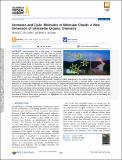Notice
This is not the latest version of this item. The latest version can be found at:https://dspace.mit.edu/handle/1721.1/141104.2
Aromatics and Cyclic Molecules in Molecular Clouds: A New Dimension of Interstellar Organic Chemistry
| dc.contributor.author | McCarthy, Michael C | |
| dc.contributor.author | McGuire, Brett A | |
| dc.date.accessioned | 2022-03-09T19:17:57Z | |
| dc.date.available | 2022-03-09T19:17:57Z | |
| dc.date.issued | 2021 | |
| dc.identifier.uri | https://hdl.handle.net/1721.1/141104 | |
| dc.description.abstract | Astrochemistry lies at the nexus of astronomy, chemistry, and molecular physics. On the basis of precise laboratory data, a rich collection of more than 200 familiar and exotic molecules have been identified in the interstellar medium, the vast majority by their unique rotational fingerprint. Despite this large body of work, there is scant evidence in the radio band for the basic building blocks of chemistry on earth-five- and six-membered rings-despite long-standing and sustained efforts during the past 50 years. In contrast, a peculiar structural motif, highly unsaturated carbon in a chainlike arrangement, is instead quite common in space. The recent astronomical detection of cyanobenzene, the simplest aromatic nitrile, in the dark molecular cloud TMC-1, and soon afterward in additional prestellar and possibly protostellar sources, establishes that aromatic chemistry is likely widespread in the earliest stages of star formation. The subsequent discovery of cyanocyclopentadienes and even cyanonaphthalenes in TMC-1 provides further evidence that organic molecules of considerable complexity are readily synthesized in regions with high visual extinction but where the low temperature and pressure are remarkably low. This review focuses on laboratory efforts now underway to understand the rich transition region between linear and planar carbon structures using microwave spectroscopy. We present key features, advantages, and disadvantages of current detection methods, a discussion of the types of molecules found in space and in the laboratory, and approaches under development to identify entirely new species in complex mixtures. Studies focusing on the cyanation of hydrocarbons and the formation of benzene from acyclic precursors are highlighted, as is the role that isotopic studies might play in elucidating the chemical pathways to ring formation. | en_US |
| dc.language.iso | en | |
| dc.publisher | American Chemical Society (ACS) | en_US |
| dc.relation.isversionof | 10.1021/ACS.JPCA.1C00129 | en_US |
| dc.rights | Article is made available in accordance with the publisher's policy and may be subject to US copyright law. Please refer to the publisher's site for terms of use. | en_US |
| dc.source | ACS | en_US |
| dc.title | Aromatics and Cyclic Molecules in Molecular Clouds: A New Dimension of Interstellar Organic Chemistry | en_US |
| dc.type | Article | en_US |
| dc.identifier.citation | McCarthy, Michael C and McGuire, Brett A. 2021. "Aromatics and Cyclic Molecules in Molecular Clouds: A New Dimension of Interstellar Organic Chemistry." Journal of Physical Chemistry A, 125 (16). | |
| dc.relation.journal | Journal of Physical Chemistry A | en_US |
| dc.eprint.version | Final published version | en_US |
| dc.type.uri | http://purl.org/eprint/type/JournalArticle | en_US |
| eprint.status | http://purl.org/eprint/status/PeerReviewed | en_US |
| dc.date.updated | 2022-03-09T19:07:43Z | |
| dspace.orderedauthors | McCarthy, MC; McGuire, BA | en_US |
| dspace.date.submission | 2022-03-09T19:07:46Z | |
| mit.journal.volume | 125 | en_US |
| mit.journal.issue | 16 | en_US |
| mit.license | PUBLISHER_POLICY | |
| mit.metadata.status | Authority Work and Publication Information Needed | en_US |
